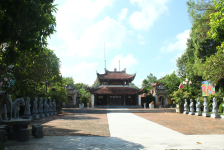
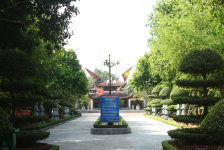
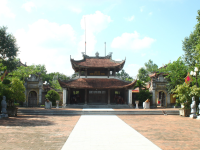
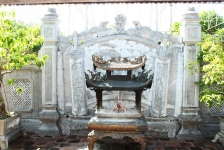
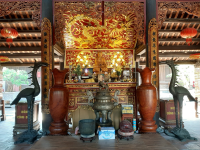
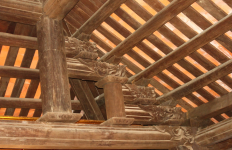
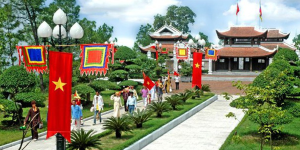
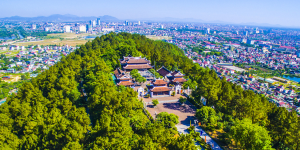
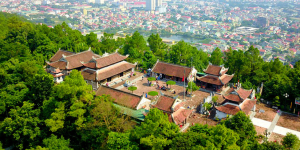
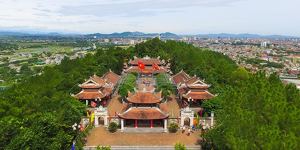
Camera tour
Price: Free
Time to visit a place: 120 phút
Open Time: 7:00 AM - Close Time: 6:00 PM
Address: Trung Do Sub-district, Vinh City, Nghe An Province
Dung Quyet Mountain and Phuong Hoang Trung Do
Dung Quyet Mountain and Phuong Hoang Trung Do are in Trung Do ward, Vinh city, which is located on the romantic Lam river.
The ancients called this a sacred land, because of the convergence of the four sacred animals (dragon, unicorn, turtle, phoenix). The one facing the west is called Long Thu (Dragon's head), the one facing the southeast is called Phuong Duc (the phoenix wing), the one facing the northeast is called Quy Boi (Turtle's back) and the one facing the southwest is called Ky Lan (unicorn or cat). Dung Quyet Mountain from the beginning of building and defending the country has been the pharynx position on the cross-country road, becoming an important military base. This land was once inhabited by the ancient Vietnamese. It is the capital city of Hoan Chau country. In 1039, Crown Prince Ly Nhat Quang, while serving as leader of Nghe An province, built Vong Hai Dai at the highest peak on Dung Quyet mountain to observe the East Sea, to detect enemy ships infiltrating Hoi Thong estuary, and set up Don Thuy next to Con Rua near the foot of the mountain to control waterways on Lam river.
The most special mark of this spiritual area is that in 1786 after defeating the Nguyen Lords in the South of Gianh river (Dai Viet territory controlled by Lord Nguyen), Nguyen Hue (1753 - 1792) - the hero of Tay Son's cloth shirt pulled his army to the North to defeat Lord Trinh. During his stay in Nghe An, the land and people of Yen Truong - Nghe An region were particularly interested by Nguyen Hue with "widespread terrain, bright weather that can be chosen to build a new capital". Emperor Quang Trung said that if he built the capital here, he could control both the South and the North, and it would be convenient for people from all over the country to come and sue with him, "first it was because of the country, the second was because of the hundreds of people's life". Phuong Hoang Trung Do was built in Dung Quyet mountain in 1788, including Outer Citadel and Inner Citadel; In the middle of the inner citadel, a 3-storey dragon building was built. This citadel was intended to be built to replace the capital Phu Xuan, named after the phoenix bird, a legendary bird, Trung Do also means the capital in the middle. The construction of the capital was in progress when Emperor Quang Trung died. Although the capital has not been built yet, the name of Phuong Hoang Trung Do has gone down in history and is associated with the name of the Emperor in cloth. From here, Phuong Hoang Trung Do becomes a landmark in the history of Vinh city's formation and development in particular and the nation's history in general.
In the period of near and modern history, Dung Quyet mountain had a outpost to fight against the French invasion (1885), the place of establishment of the Phuc Viet Association (1925) and the place of the protest on May 1, 1930 to open the beginning of the Nghe Tinh Soviet climax. During the period of anti-Americanism and national salvation, this place was one of the key points where the fiercest battles took place. 07 units and 05 individuals were conferred the title of Hero by the State in this area.
To remember the great merits of the cloth hero Nguyen Hue - Quang Trung, an outstanding son of the Ho family clan in Nghe An, it was approved by the Government, in 2005 on the occasion of the 220th anniversary of the Emperor's edict to build Phuong Hoang Trung Do, Nghe An province started construction of the Emperor Quang Trung's temple on the second peak. The temple is 97m high above sea level, belonging to the Phuong Duc branch. In 2008, Emperor Quang Trung's temple was inaugurated, welcoming visitors. The temple consists of main items: lower hall, middle hall, upper hall, left house, right house, internal ritual house, external ritual house according to the traditional architecture of the nation.
Every year at the temple of Emperor Quang Trung, there are 2 big holidays: 29th July of the lunar calendar - the anniversary of Emperor Quang Trung's death, and 5th January - the anniversary of the Ngoc Hoi - Dong Da victory. On this occasion, people everywhere in and outside the province will celebrate at the temple, honoring the great merits of the national hero Quang Trung - Nguyen Hue, who has fought against foreign invaders to unify the country.
Dung Quyet Mountain and the temple of Emperor Quang Trung are important landmarks, historical and cultural works in the complex of Quyet Mountain Park Tourist Area that have been planned and implemented.
Phuong Hoang Trung Do is one of the first three monuments of Nghe An recognized by the State of Democratic Republic of Vietnam as a "national historical monument" in Decision No. 313/QD-VH on April 28th, 1962, of Ministry of Culture.
Distance: 980 m
Distance: 1.07 km
Distance: 1.32 km
Distance: 2.29 km
Distance: 2.36 km
Distance: 2.60 km
Distance: 3.12 km
Distance: 3.15 km
Distance: 3.18 km
Distance: 1.57 km
Distance: 1.84 km
Distance: 2.18 km
Distance: 2.23 km
Distance: 2.30 km
Distance: 2.51 km
Distance: 2.51 km
Distance: 2.55 km
Distance: 2.59 km
Distance: 2.61 km
Distance: 2.94 km
Distance: 3 km
Distance: 3.01 km
Distance: 3.02 km
Distance: 3.09 km
Distance: 3.16 km
Distance: 3.35 km
Distance: 3.35 km
Distance: 0 m
Distance: 50 m
Distance: 70 m
Distance: 870 m
Distance: 1.12 km
Distance: 1.13 km
Distance: 1.16 km
Distance: 1.20 km
Distance: 2.24 km
Distance: 2.32 km
Distance: 2.50 km
Distance: 2.59 km
Distance: 2.59 km
Distance: 2.60 km
Distance: 2.64 km
Distance: 2.70 km
Distance: 2.76 km
Distance: 2.08 km
Distance: 2.28 km
Distance: 2.41 km
Distance: 2.76 km
Distance: 2.88 km
Distance: 2.96 km
Distance: 2.98 km
Distance: 3 km
Distance: 3.03 km
Distance: 3.07 km
Distance: 3.58 km
Distance: 3.68 km
Distance: 3.80 km
Distance: 3.91 km
Distance: 3.97 km
Distance: 4.03 km
Distance: 4.05 km



0
No Comment!